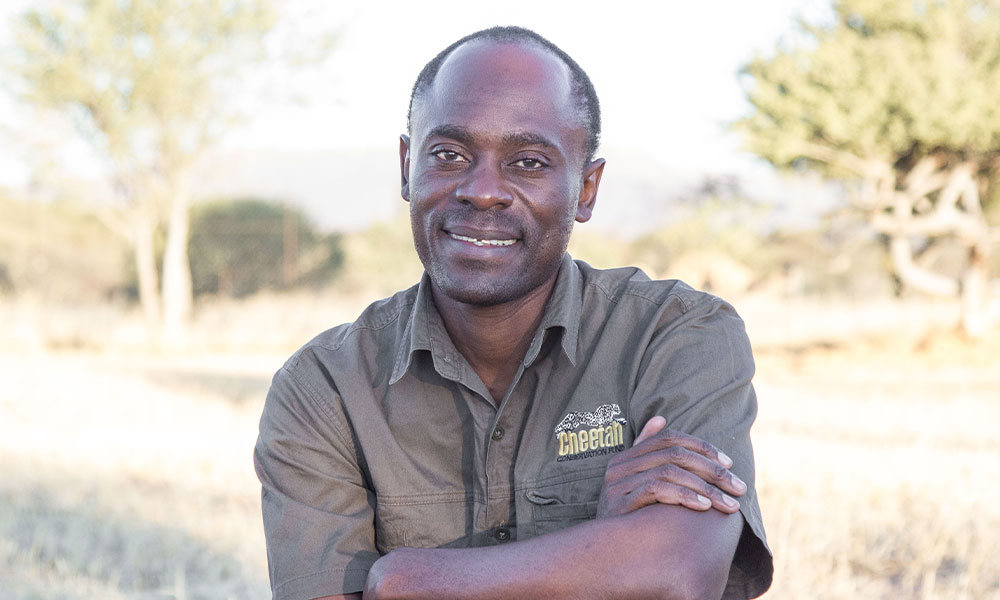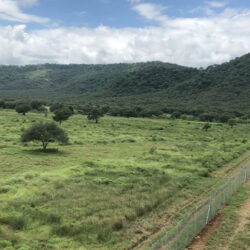The Ecology of the Landscape Down to the Smallest Part
-

- by Matti Nghikembua October 15, 2024

One of the greatest challenges to the cheetah’s survival in the wild is the loss of its natural habitat. I’ve been working with Cheetah Conservation Fund (CCF) in Namibia since 1998 studying. I work directly in Namibia to study the ecology of the arid landscape, specializing in the soil, grasses, and trees that form the foundation of this ecosystem. Though these parts of the landscape are not often talked about, changes to the soil and plant life have downstream effects that can dramatically impact wildlife – even if those changes aren’t immediately visible.
Increased plant growth is often seen as a positive thing for air quality and erosion control, but when plants grow unchecked and are no longer grazed by wildlife, this balance can tip toward overgrowth. Grazing animals (those that eat grasses) and browsing animals (those that eat leaves from bushes and trees) play a crucial role in maintaining a healthy ecosystem. Over the past century, the loss of large herbivores like elephants and rhinos (known as megafauna) has resulted in the overgrowth of native thorny bushes – a process known as bush encroachment. While the disappearance of these iconic species is well known, their absence has had another less visible consequence: the loss of the open spaces that cheetahs need to hunt effectively.
This bush encroachment doesn’t just affect wildlife. It also reduces available grazing land for livestock, impacting the livelihoods of local farmers. As open spaces diminish, cheetahs come into closer contact with human settlements and livestock, which not only heightens the risk of conflict but also, for instance in Somaliland where we also work, increases the likelihood of illegal trade in cheetah cubs. In fact, while habitat loss may be the least known of the three main threats to the species’ survival, it is the most impactful because it drives the other two – human-wildlife conflict and illegal wildlife trade.
At CCF, we have spent the past three decades working to address bush encroachment by carefully thinning overgrown areas and restoring balance to the ecosystem. Through our habitat restoration efforts, we’re not only improving conditions for cheetahs but also enhancing the productivity of rangelands for communities that share this landscape with wildlife.


Thanks to the support of donors like you, we’ve been able to make significant progress. Our approach is scientifically informed, using tools like camera traps and soil monitoring to assess how bush thinning affects wildlife and biodiversity. We take care to maintain a mosaic of thinned and unthinned areas to ensure that wildlife – from predators like cheetahs to smaller species – can thrive in a balanced environment. Additionally, we’re turning harvested bush into sustainable products like BUSHBLOK®, biochar, and livestock feed creating economic opportunities for local communities while supporting conservation goals. And our work is Forest Stewardship Council (FSC) Certified, which assures that all CCF activities are done in an ecological sustainable manner.
We’re asking for your support to continue this work.
By supporting us with a donation, you’re helping to restore rangelands, reduce human-wildlife conflict, and create more opportunities for sustainable land use. Every contribution ensures that cheetahs have access to the open spaces they need to survive, while also helping local communities coexist with wildlife more harmoniously.
At CCF, we know that the future of the cheetah depends on maintaining healthy ecosystems. With your help, we can continue this essential work and make a lasting impact on both wildlife and the people who live alongside it.

Cheetah Conservation Fund (CCF) supports both wildlife and people by aligning with the United Nations Sustainable Development Goals (SDGs). Through projects like the Model Farm, Biomass Energy, and Future Farmers of Africa, CCF creates new income opportunities and jobs in conservation and clean energy.
Our environmental education programs in Namibia and Somaliland foster lifelong learning and professional growth. With renewable energy initiatives like BUSHBLOK® and SteamBio Africa, we promote clean, sustainable energy solutions. By restoring habitats and protecting biodiversity, CCF contributes to climate action and the sustainable use of land, ensuring a brighter future for both cheetahs and local communities.
FOCUS ON FIFTEEN: PROTECTING LIFE ON LAND




The content of this publication has not been approved by the United Nations and does not reflect the views of the United Nations or its officials or Member States.
Related Reading




